Retail Management Analysis: John Lewis, Semester 2 Report
VerifiedAdded on 2023/01/12
|12
|3046
|95
Report
AI Summary
This report provides a comprehensive analysis of retail management, focusing on the application of concepts to John Lewis, a British fashion retail partnership. The report begins with an introduction to retail and the company, followed by an identification of changes in the fashion retail industry, including a PESTLE analysis of the UK market. It then examines alterations within the company environment using SWOT analysis. The report suggests and discusses strategies and tactics, including the Ansoff matrix and Porter's Generic Strategies, to enhance the company's growth. Finally, it offers recommendations for John Lewis to address current challenges and capitalize on opportunities in the evolving retail landscape. The report covers various aspects of retail management, from macro and micro environmental factors to strategic implementations and provides a valuable overview of the fashion retail sector.
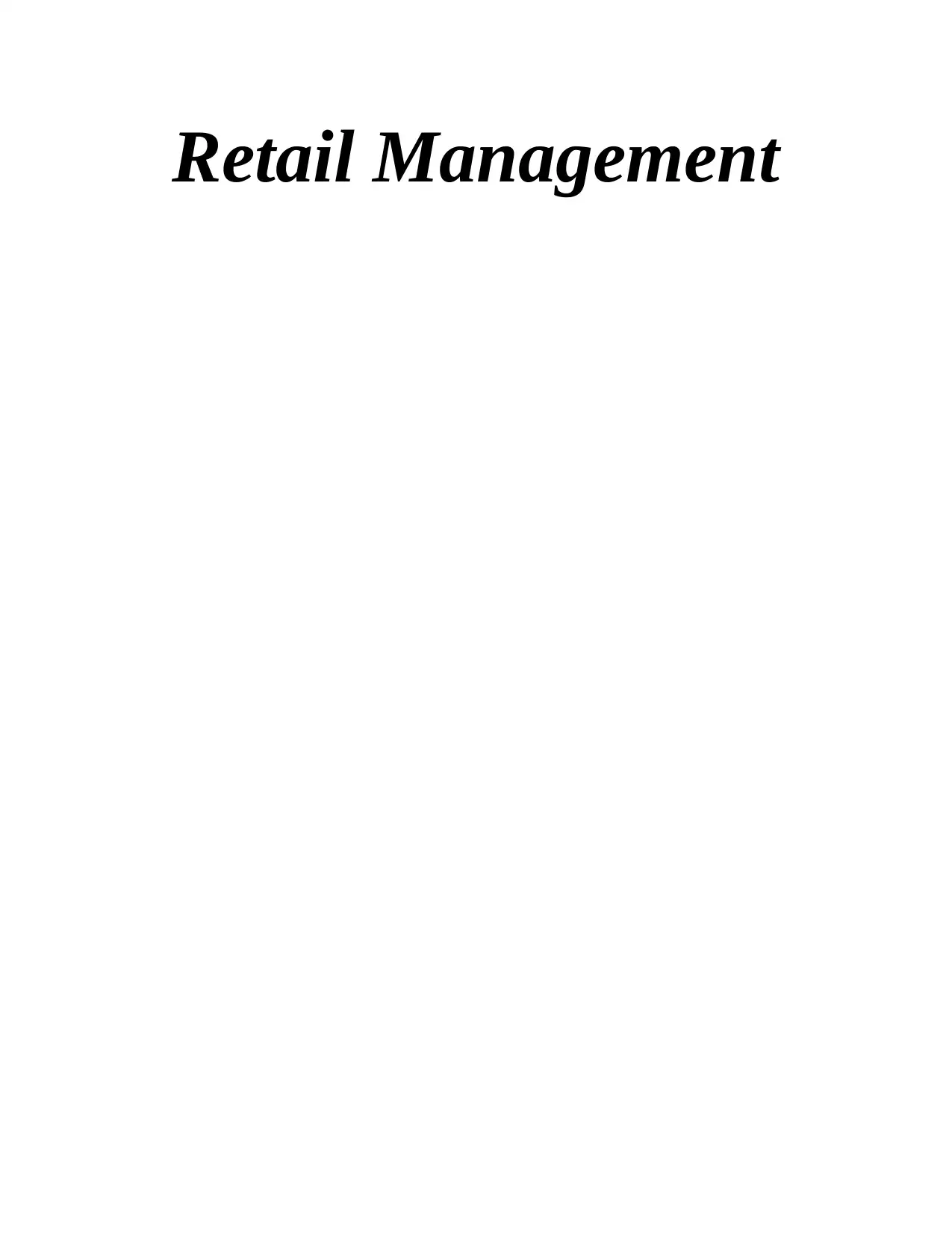
Retail Management
Paraphrase This Document
Need a fresh take? Get an instant paraphrase of this document with our AI Paraphraser
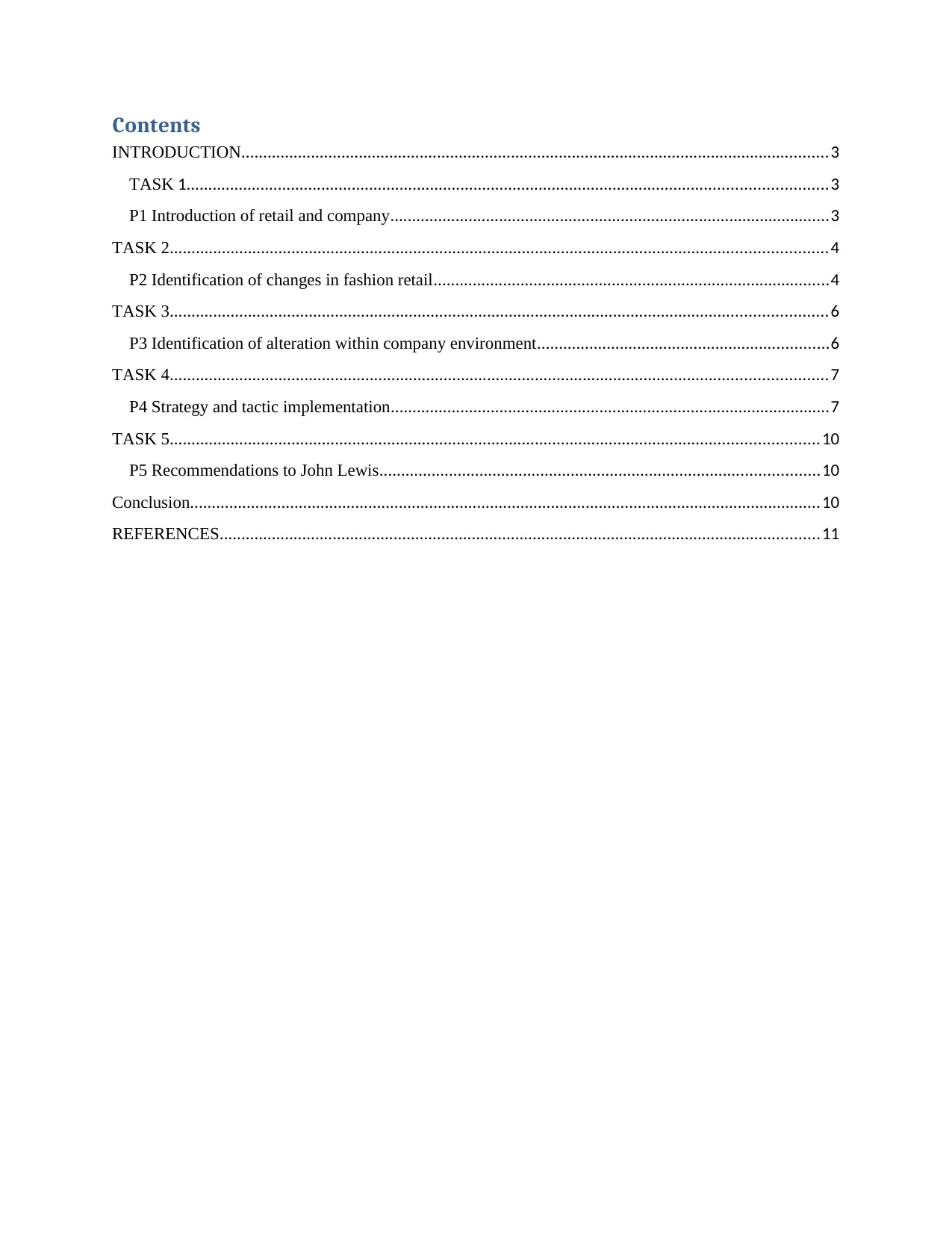
Contents
INTRODUCTION.......................................................................................................................................3
TASK 1...................................................................................................................................................3
P1 Introduction of retail and company.....................................................................................................3
TASK 2.......................................................................................................................................................4
P2 Identification of changes in fashion retail...........................................................................................4
TASK 3.......................................................................................................................................................6
P3 Identification of alteration within company environment...................................................................6
TASK 4.......................................................................................................................................................7
P4 Strategy and tactic implementation.....................................................................................................7
TASK 5.....................................................................................................................................................10
P5 Recommendations to John Lewis.....................................................................................................10
Conclusion.................................................................................................................................................10
REFERENCES..........................................................................................................................................11
INTRODUCTION.......................................................................................................................................3
TASK 1...................................................................................................................................................3
P1 Introduction of retail and company.....................................................................................................3
TASK 2.......................................................................................................................................................4
P2 Identification of changes in fashion retail...........................................................................................4
TASK 3.......................................................................................................................................................6
P3 Identification of alteration within company environment...................................................................6
TASK 4.......................................................................................................................................................7
P4 Strategy and tactic implementation.....................................................................................................7
TASK 5.....................................................................................................................................................10
P5 Recommendations to John Lewis.....................................................................................................10
Conclusion.................................................................................................................................................10
REFERENCES..........................................................................................................................................11
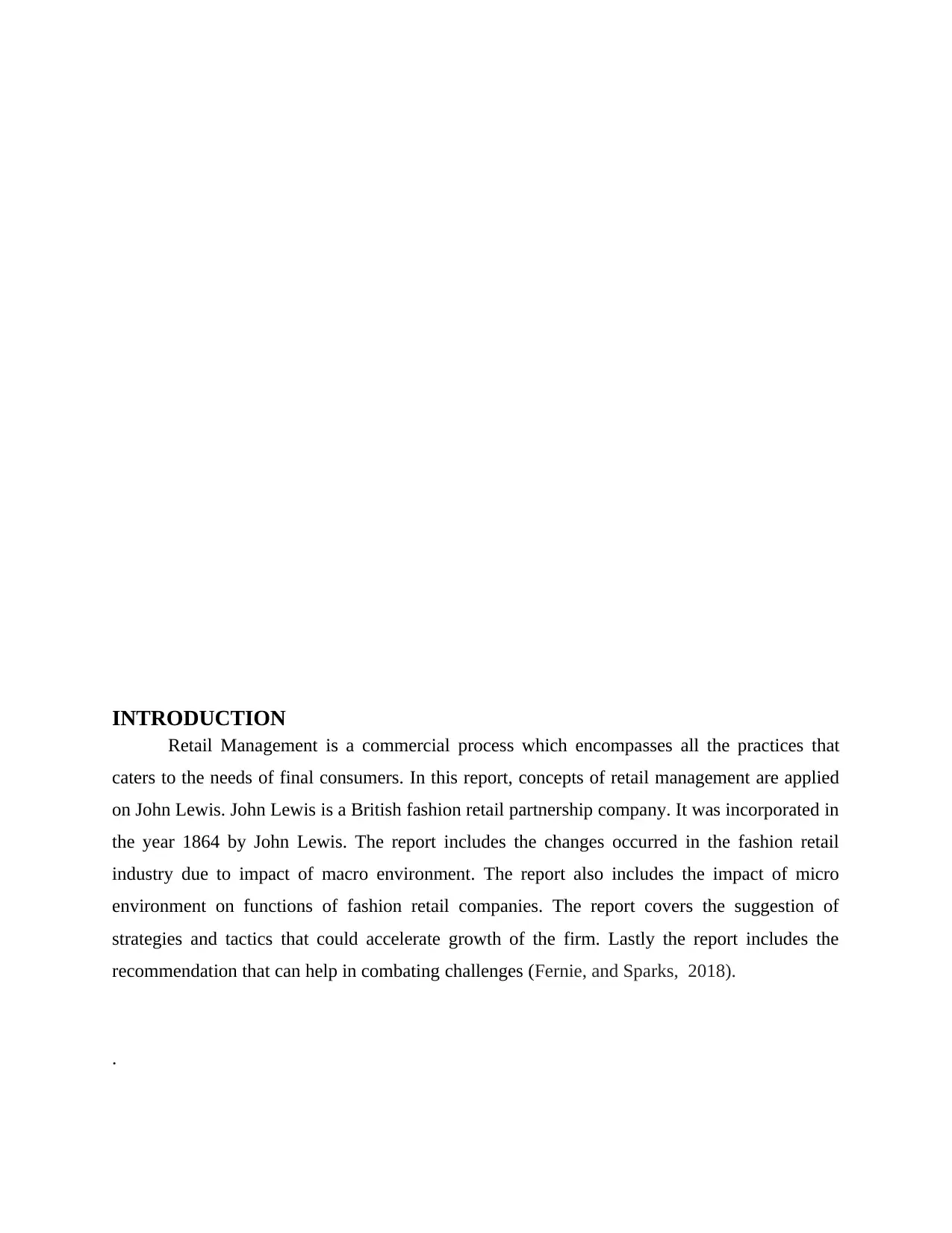
INTRODUCTION
Retail Management is a commercial process which encompasses all the practices that
caters to the needs of final consumers. In this report, concepts of retail management are applied
on John Lewis. John Lewis is a British fashion retail partnership company. It was incorporated in
the year 1864 by John Lewis. The report includes the changes occurred in the fashion retail
industry due to impact of macro environment. The report also includes the impact of micro
environment on functions of fashion retail companies. The report covers the suggestion of
strategies and tactics that could accelerate growth of the firm. Lastly the report includes the
recommendation that can help in combating challenges (Fernie, and Sparks, 2018).
.
Retail Management is a commercial process which encompasses all the practices that
caters to the needs of final consumers. In this report, concepts of retail management are applied
on John Lewis. John Lewis is a British fashion retail partnership company. It was incorporated in
the year 1864 by John Lewis. The report includes the changes occurred in the fashion retail
industry due to impact of macro environment. The report also includes the impact of micro
environment on functions of fashion retail companies. The report covers the suggestion of
strategies and tactics that could accelerate growth of the firm. Lastly the report includes the
recommendation that can help in combating challenges (Fernie, and Sparks, 2018).
.
⊘ This is a preview!⊘
Do you want full access?
Subscribe today to unlock all pages.

Trusted by 1+ million students worldwide
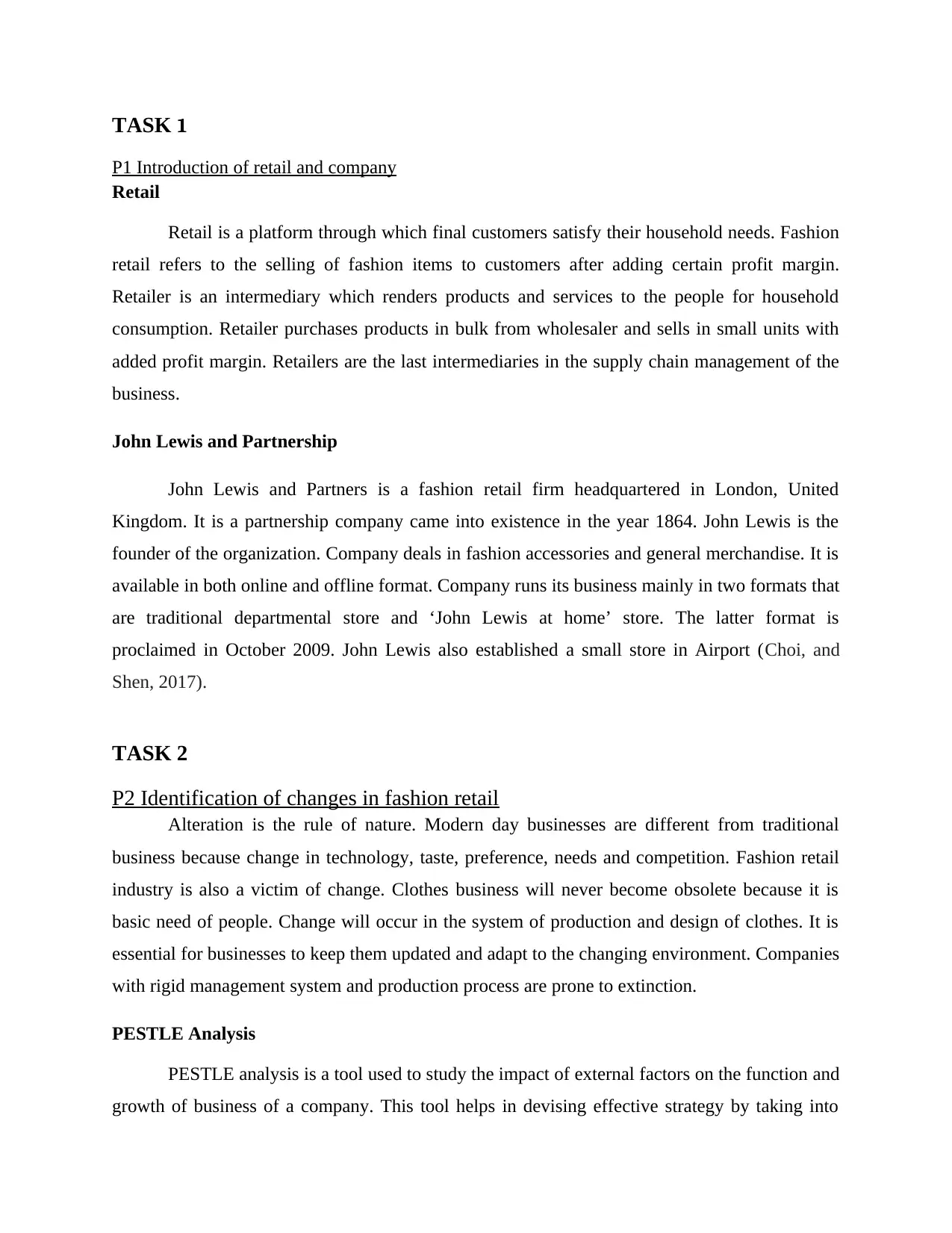
TASK 1
P1 Introduction of retail and company
Retail
Retail is a platform through which final customers satisfy their household needs. Fashion
retail refers to the selling of fashion items to customers after adding certain profit margin.
Retailer is an intermediary which renders products and services to the people for household
consumption. Retailer purchases products in bulk from wholesaler and sells in small units with
added profit margin. Retailers are the last intermediaries in the supply chain management of the
business.
John Lewis and Partnership
John Lewis and Partners is a fashion retail firm headquartered in London, United
Kingdom. It is a partnership company came into existence in the year 1864. John Lewis is the
founder of the organization. Company deals in fashion accessories and general merchandise. It is
available in both online and offline format. Company runs its business mainly in two formats that
are traditional departmental store and ‘John Lewis at home’ store. The latter format is
proclaimed in October 2009. John Lewis also established a small store in Airport (Choi, and
Shen, 2017).
TASK 2
P2 Identification of changes in fashion retail
Alteration is the rule of nature. Modern day businesses are different from traditional
business because change in technology, taste, preference, needs and competition. Fashion retail
industry is also a victim of change. Clothes business will never become obsolete because it is
basic need of people. Change will occur in the system of production and design of clothes. It is
essential for businesses to keep them updated and adapt to the changing environment. Companies
with rigid management system and production process are prone to extinction.
PESTLE Analysis
PESTLE analysis is a tool used to study the impact of external factors on the function and
growth of business of a company. This tool helps in devising effective strategy by taking into
P1 Introduction of retail and company
Retail
Retail is a platform through which final customers satisfy their household needs. Fashion
retail refers to the selling of fashion items to customers after adding certain profit margin.
Retailer is an intermediary which renders products and services to the people for household
consumption. Retailer purchases products in bulk from wholesaler and sells in small units with
added profit margin. Retailers are the last intermediaries in the supply chain management of the
business.
John Lewis and Partnership
John Lewis and Partners is a fashion retail firm headquartered in London, United
Kingdom. It is a partnership company came into existence in the year 1864. John Lewis is the
founder of the organization. Company deals in fashion accessories and general merchandise. It is
available in both online and offline format. Company runs its business mainly in two formats that
are traditional departmental store and ‘John Lewis at home’ store. The latter format is
proclaimed in October 2009. John Lewis also established a small store in Airport (Choi, and
Shen, 2017).
TASK 2
P2 Identification of changes in fashion retail
Alteration is the rule of nature. Modern day businesses are different from traditional
business because change in technology, taste, preference, needs and competition. Fashion retail
industry is also a victim of change. Clothes business will never become obsolete because it is
basic need of people. Change will occur in the system of production and design of clothes. It is
essential for businesses to keep them updated and adapt to the changing environment. Companies
with rigid management system and production process are prone to extinction.
PESTLE Analysis
PESTLE analysis is a tool used to study the impact of external factors on the function and
growth of business of a company. This tool helps in devising effective strategy by taking into
Paraphrase This Document
Need a fresh take? Get an instant paraphrase of this document with our AI Paraphraser
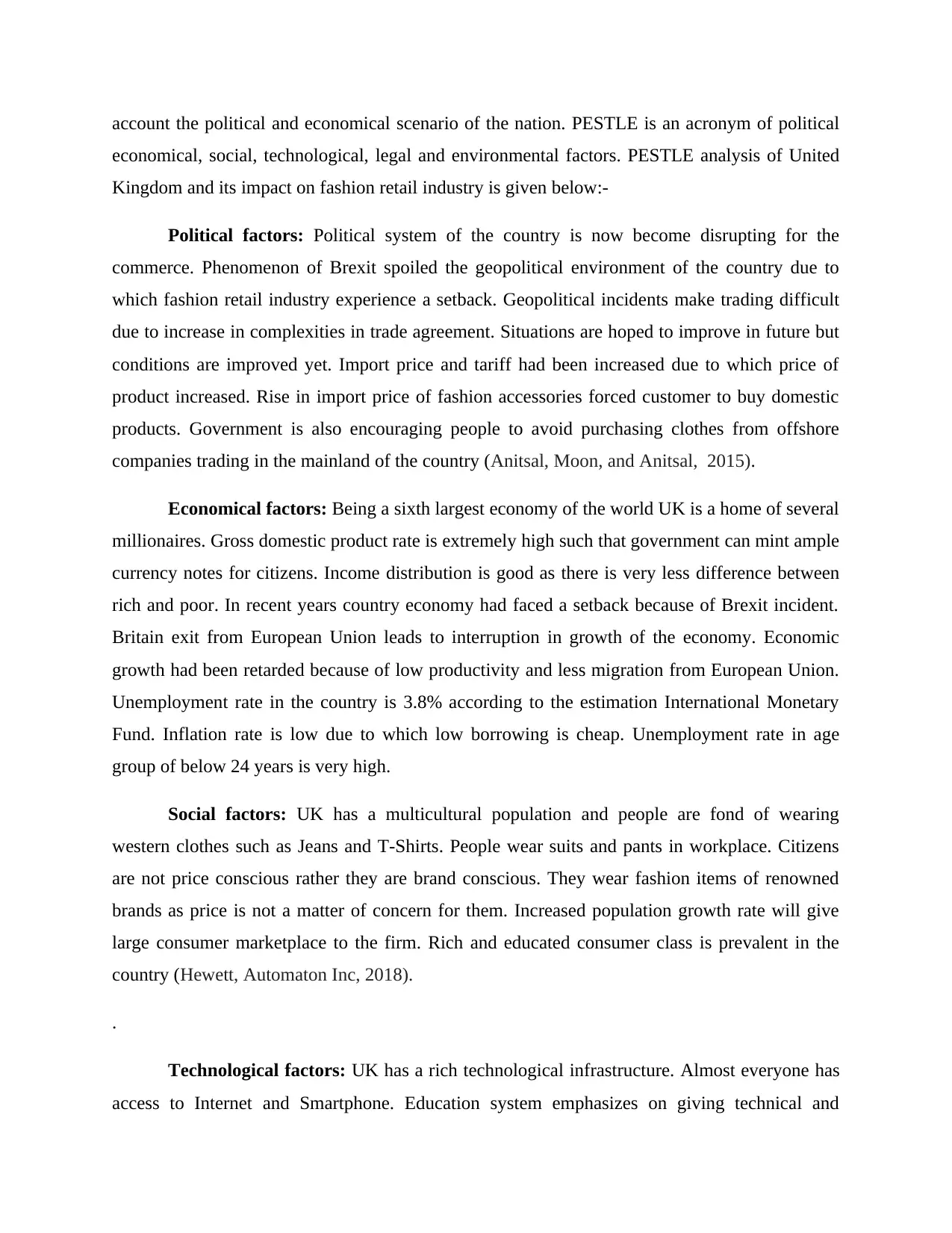
account the political and economical scenario of the nation. PESTLE is an acronym of political
economical, social, technological, legal and environmental factors. PESTLE analysis of United
Kingdom and its impact on fashion retail industry is given below:-
Political factors: Political system of the country is now become disrupting for the
commerce. Phenomenon of Brexit spoiled the geopolitical environment of the country due to
which fashion retail industry experience a setback. Geopolitical incidents make trading difficult
due to increase in complexities in trade agreement. Situations are hoped to improve in future but
conditions are improved yet. Import price and tariff had been increased due to which price of
product increased. Rise in import price of fashion accessories forced customer to buy domestic
products. Government is also encouraging people to avoid purchasing clothes from offshore
companies trading in the mainland of the country (Anitsal, Moon, and Anitsal, 2015).
Economical factors: Being a sixth largest economy of the world UK is a home of several
millionaires. Gross domestic product rate is extremely high such that government can mint ample
currency notes for citizens. Income distribution is good as there is very less difference between
rich and poor. In recent years country economy had faced a setback because of Brexit incident.
Britain exit from European Union leads to interruption in growth of the economy. Economic
growth had been retarded because of low productivity and less migration from European Union.
Unemployment rate in the country is 3.8% according to the estimation International Monetary
Fund. Inflation rate is low due to which low borrowing is cheap. Unemployment rate in age
group of below 24 years is very high.
Social factors: UK has a multicultural population and people are fond of wearing
western clothes such as Jeans and T-Shirts. People wear suits and pants in workplace. Citizens
are not price conscious rather they are brand conscious. They wear fashion items of renowned
brands as price is not a matter of concern for them. Increased population growth rate will give
large consumer marketplace to the firm. Rich and educated consumer class is prevalent in the
country (Hewett, Automaton Inc, 2018).
.
Technological factors: UK has a rich technological infrastructure. Almost everyone has
access to Internet and Smartphone. Education system emphasizes on giving technical and
economical, social, technological, legal and environmental factors. PESTLE analysis of United
Kingdom and its impact on fashion retail industry is given below:-
Political factors: Political system of the country is now become disrupting for the
commerce. Phenomenon of Brexit spoiled the geopolitical environment of the country due to
which fashion retail industry experience a setback. Geopolitical incidents make trading difficult
due to increase in complexities in trade agreement. Situations are hoped to improve in future but
conditions are improved yet. Import price and tariff had been increased due to which price of
product increased. Rise in import price of fashion accessories forced customer to buy domestic
products. Government is also encouraging people to avoid purchasing clothes from offshore
companies trading in the mainland of the country (Anitsal, Moon, and Anitsal, 2015).
Economical factors: Being a sixth largest economy of the world UK is a home of several
millionaires. Gross domestic product rate is extremely high such that government can mint ample
currency notes for citizens. Income distribution is good as there is very less difference between
rich and poor. In recent years country economy had faced a setback because of Brexit incident.
Britain exit from European Union leads to interruption in growth of the economy. Economic
growth had been retarded because of low productivity and less migration from European Union.
Unemployment rate in the country is 3.8% according to the estimation International Monetary
Fund. Inflation rate is low due to which low borrowing is cheap. Unemployment rate in age
group of below 24 years is very high.
Social factors: UK has a multicultural population and people are fond of wearing
western clothes such as Jeans and T-Shirts. People wear suits and pants in workplace. Citizens
are not price conscious rather they are brand conscious. They wear fashion items of renowned
brands as price is not a matter of concern for them. Increased population growth rate will give
large consumer marketplace to the firm. Rich and educated consumer class is prevalent in the
country (Hewett, Automaton Inc, 2018).
.
Technological factors: UK has a rich technological infrastructure. Almost everyone has
access to Internet and Smartphone. Education system emphasizes on giving technical and
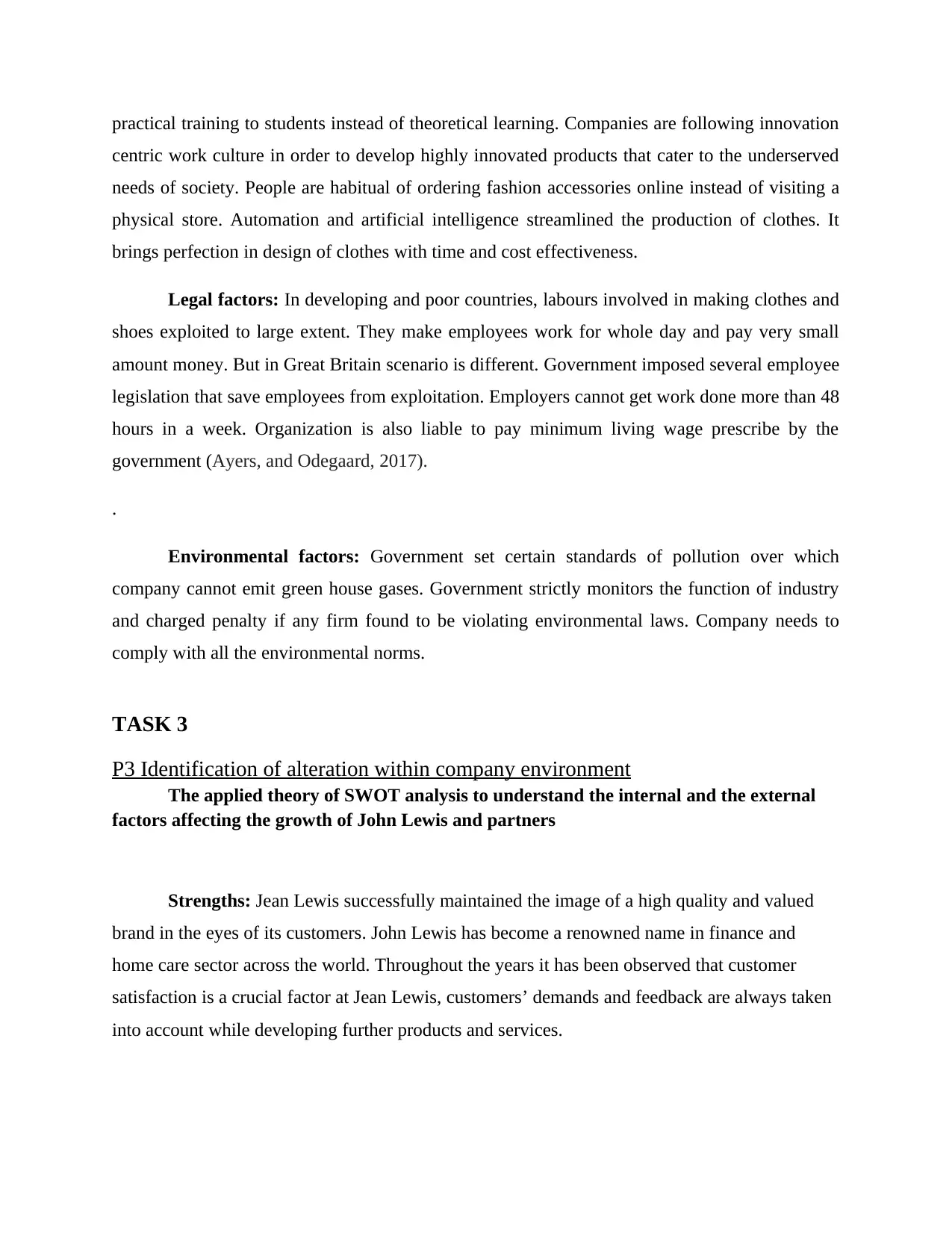
practical training to students instead of theoretical learning. Companies are following innovation
centric work culture in order to develop highly innovated products that cater to the underserved
needs of society. People are habitual of ordering fashion accessories online instead of visiting a
physical store. Automation and artificial intelligence streamlined the production of clothes. It
brings perfection in design of clothes with time and cost effectiveness.
Legal factors: In developing and poor countries, labours involved in making clothes and
shoes exploited to large extent. They make employees work for whole day and pay very small
amount money. But in Great Britain scenario is different. Government imposed several employee
legislation that save employees from exploitation. Employers cannot get work done more than 48
hours in a week. Organization is also liable to pay minimum living wage prescribe by the
government (Ayers, and Odegaard, 2017).
.
Environmental factors: Government set certain standards of pollution over which
company cannot emit green house gases. Government strictly monitors the function of industry
and charged penalty if any firm found to be violating environmental laws. Company needs to
comply with all the environmental norms.
TASK 3
P3 Identification of alteration within company environment
The applied theory of SWOT analysis to understand the internal and the external
factors affecting the growth of John Lewis and partners
Strengths: Jean Lewis successfully maintained the image of a high quality and valued
brand in the eyes of its customers. John Lewis has become a renowned name in finance and
home care sector across the world. Throughout the years it has been observed that customer
satisfaction is a crucial factor at Jean Lewis, customers’ demands and feedback are always taken
into account while developing further products and services.
centric work culture in order to develop highly innovated products that cater to the underserved
needs of society. People are habitual of ordering fashion accessories online instead of visiting a
physical store. Automation and artificial intelligence streamlined the production of clothes. It
brings perfection in design of clothes with time and cost effectiveness.
Legal factors: In developing and poor countries, labours involved in making clothes and
shoes exploited to large extent. They make employees work for whole day and pay very small
amount money. But in Great Britain scenario is different. Government imposed several employee
legislation that save employees from exploitation. Employers cannot get work done more than 48
hours in a week. Organization is also liable to pay minimum living wage prescribe by the
government (Ayers, and Odegaard, 2017).
.
Environmental factors: Government set certain standards of pollution over which
company cannot emit green house gases. Government strictly monitors the function of industry
and charged penalty if any firm found to be violating environmental laws. Company needs to
comply with all the environmental norms.
TASK 3
P3 Identification of alteration within company environment
The applied theory of SWOT analysis to understand the internal and the external
factors affecting the growth of John Lewis and partners
Strengths: Jean Lewis successfully maintained the image of a high quality and valued
brand in the eyes of its customers. John Lewis has become a renowned name in finance and
home care sector across the world. Throughout the years it has been observed that customer
satisfaction is a crucial factor at Jean Lewis, customers’ demands and feedback are always taken
into account while developing further products and services.
⊘ This is a preview!⊘
Do you want full access?
Subscribe today to unlock all pages.

Trusted by 1+ million students worldwide
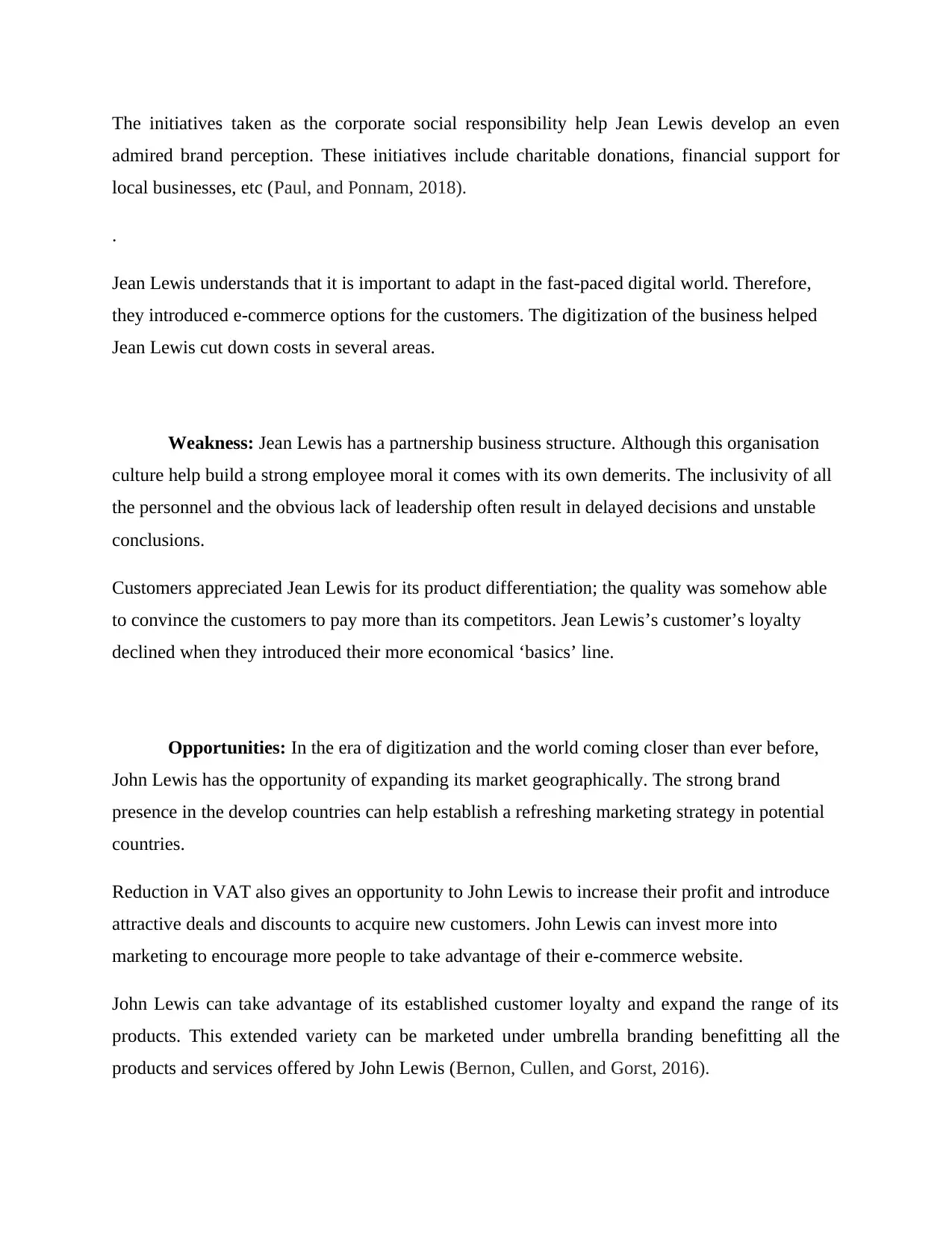
The initiatives taken as the corporate social responsibility help Jean Lewis develop an even
admired brand perception. These initiatives include charitable donations, financial support for
local businesses, etc (Paul, and Ponnam, 2018).
.
Jean Lewis understands that it is important to adapt in the fast-paced digital world. Therefore,
they introduced e-commerce options for the customers. The digitization of the business helped
Jean Lewis cut down costs in several areas.
Weakness: Jean Lewis has a partnership business structure. Although this organisation
culture help build a strong employee moral it comes with its own demerits. The inclusivity of all
the personnel and the obvious lack of leadership often result in delayed decisions and unstable
conclusions.
Customers appreciated Jean Lewis for its product differentiation; the quality was somehow able
to convince the customers to pay more than its competitors. Jean Lewis’s customer’s loyalty
declined when they introduced their more economical ‘basics’ line.
Opportunities: In the era of digitization and the world coming closer than ever before,
John Lewis has the opportunity of expanding its market geographically. The strong brand
presence in the develop countries can help establish a refreshing marketing strategy in potential
countries.
Reduction in VAT also gives an opportunity to John Lewis to increase their profit and introduce
attractive deals and discounts to acquire new customers. John Lewis can invest more into
marketing to encourage more people to take advantage of their e-commerce website.
John Lewis can take advantage of its established customer loyalty and expand the range of its
products. This extended variety can be marketed under umbrella branding benefitting all the
products and services offered by John Lewis (Bernon, Cullen, and Gorst, 2016).
admired brand perception. These initiatives include charitable donations, financial support for
local businesses, etc (Paul, and Ponnam, 2018).
.
Jean Lewis understands that it is important to adapt in the fast-paced digital world. Therefore,
they introduced e-commerce options for the customers. The digitization of the business helped
Jean Lewis cut down costs in several areas.
Weakness: Jean Lewis has a partnership business structure. Although this organisation
culture help build a strong employee moral it comes with its own demerits. The inclusivity of all
the personnel and the obvious lack of leadership often result in delayed decisions and unstable
conclusions.
Customers appreciated Jean Lewis for its product differentiation; the quality was somehow able
to convince the customers to pay more than its competitors. Jean Lewis’s customer’s loyalty
declined when they introduced their more economical ‘basics’ line.
Opportunities: In the era of digitization and the world coming closer than ever before,
John Lewis has the opportunity of expanding its market geographically. The strong brand
presence in the develop countries can help establish a refreshing marketing strategy in potential
countries.
Reduction in VAT also gives an opportunity to John Lewis to increase their profit and introduce
attractive deals and discounts to acquire new customers. John Lewis can invest more into
marketing to encourage more people to take advantage of their e-commerce website.
John Lewis can take advantage of its established customer loyalty and expand the range of its
products. This extended variety can be marketed under umbrella branding benefitting all the
products and services offered by John Lewis (Bernon, Cullen, and Gorst, 2016).
Paraphrase This Document
Need a fresh take? Get an instant paraphrase of this document with our AI Paraphraser
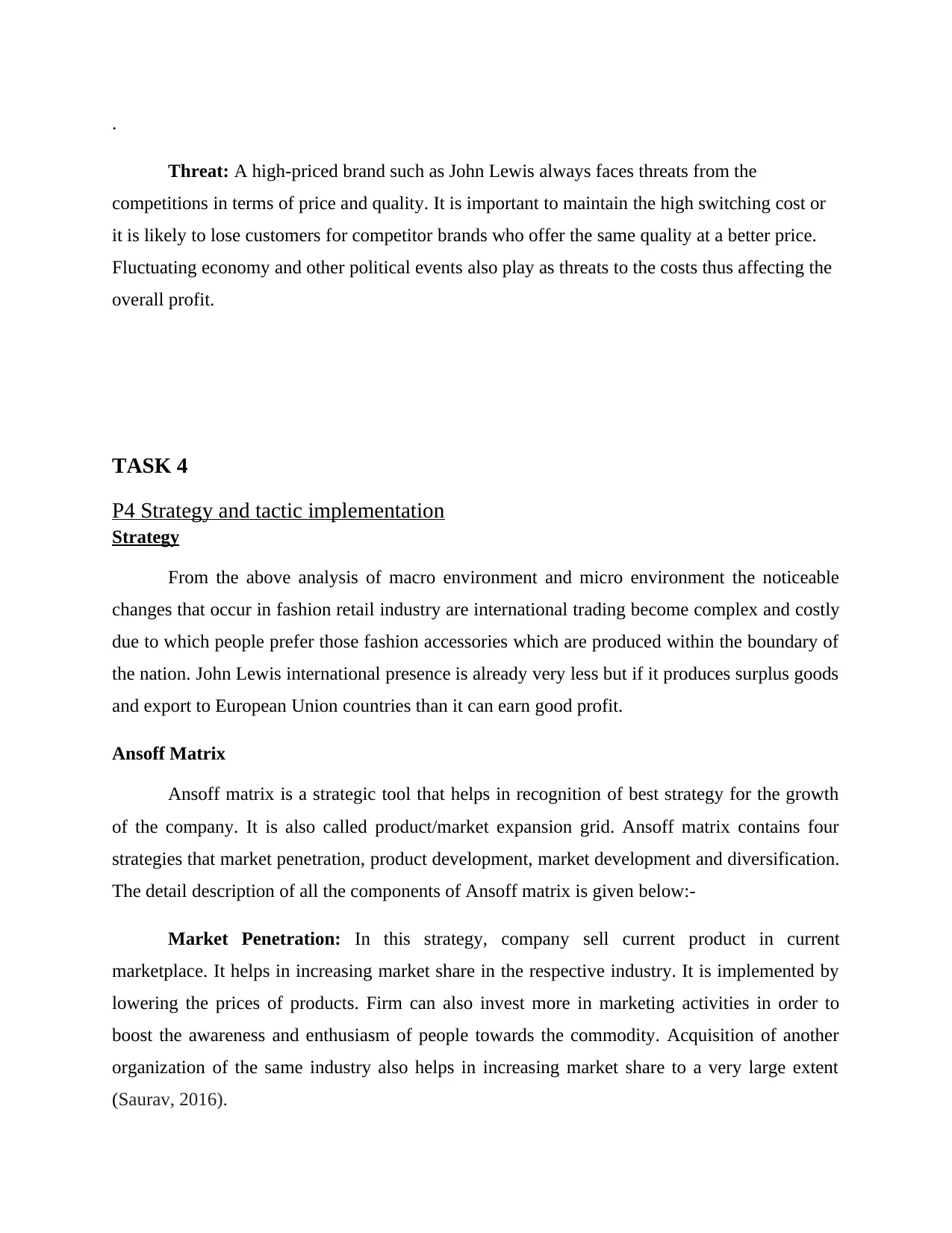
.
Threat: A high-priced brand such as John Lewis always faces threats from the
competitions in terms of price and quality. It is important to maintain the high switching cost or
it is likely to lose customers for competitor brands who offer the same quality at a better price.
Fluctuating economy and other political events also play as threats to the costs thus affecting the
overall profit.
TASK 4
P4 Strategy and tactic implementation
Strategy
From the above analysis of macro environment and micro environment the noticeable
changes that occur in fashion retail industry are international trading become complex and costly
due to which people prefer those fashion accessories which are produced within the boundary of
the nation. John Lewis international presence is already very less but if it produces surplus goods
and export to European Union countries than it can earn good profit.
Ansoff Matrix
Ansoff matrix is a strategic tool that helps in recognition of best strategy for the growth
of the company. It is also called product/market expansion grid. Ansoff matrix contains four
strategies that market penetration, product development, market development and diversification.
The detail description of all the components of Ansoff matrix is given below:-
Market Penetration: In this strategy, company sell current product in current
marketplace. It helps in increasing market share in the respective industry. It is implemented by
lowering the prices of products. Firm can also invest more in marketing activities in order to
boost the awareness and enthusiasm of people towards the commodity. Acquisition of another
organization of the same industry also helps in increasing market share to a very large extent
(Saurav, 2016).
Threat: A high-priced brand such as John Lewis always faces threats from the
competitions in terms of price and quality. It is important to maintain the high switching cost or
it is likely to lose customers for competitor brands who offer the same quality at a better price.
Fluctuating economy and other political events also play as threats to the costs thus affecting the
overall profit.
TASK 4
P4 Strategy and tactic implementation
Strategy
From the above analysis of macro environment and micro environment the noticeable
changes that occur in fashion retail industry are international trading become complex and costly
due to which people prefer those fashion accessories which are produced within the boundary of
the nation. John Lewis international presence is already very less but if it produces surplus goods
and export to European Union countries than it can earn good profit.
Ansoff Matrix
Ansoff matrix is a strategic tool that helps in recognition of best strategy for the growth
of the company. It is also called product/market expansion grid. Ansoff matrix contains four
strategies that market penetration, product development, market development and diversification.
The detail description of all the components of Ansoff matrix is given below:-
Market Penetration: In this strategy, company sell current product in current
marketplace. It helps in increasing market share in the respective industry. It is implemented by
lowering the prices of products. Firm can also invest more in marketing activities in order to
boost the awareness and enthusiasm of people towards the commodity. Acquisition of another
organization of the same industry also helps in increasing market share to a very large extent
(Saurav, 2016).
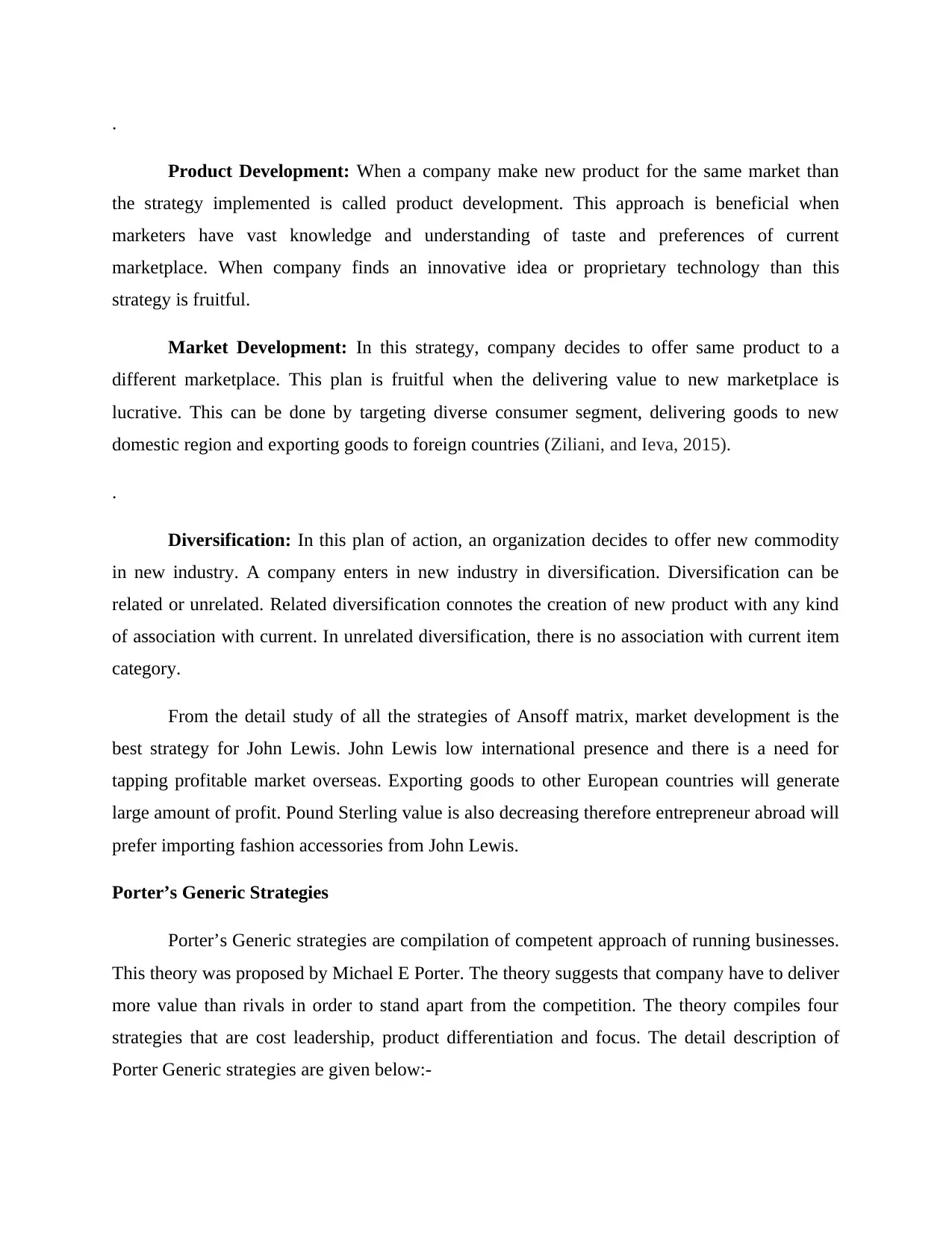
.
Product Development: When a company make new product for the same market than
the strategy implemented is called product development. This approach is beneficial when
marketers have vast knowledge and understanding of taste and preferences of current
marketplace. When company finds an innovative idea or proprietary technology than this
strategy is fruitful.
Market Development: In this strategy, company decides to offer same product to a
different marketplace. This plan is fruitful when the delivering value to new marketplace is
lucrative. This can be done by targeting diverse consumer segment, delivering goods to new
domestic region and exporting goods to foreign countries (Ziliani, and Ieva, 2015).
.
Diversification: In this plan of action, an organization decides to offer new commodity
in new industry. A company enters in new industry in diversification. Diversification can be
related or unrelated. Related diversification connotes the creation of new product with any kind
of association with current. In unrelated diversification, there is no association with current item
category.
From the detail study of all the strategies of Ansoff matrix, market development is the
best strategy for John Lewis. John Lewis low international presence and there is a need for
tapping profitable market overseas. Exporting goods to other European countries will generate
large amount of profit. Pound Sterling value is also decreasing therefore entrepreneur abroad will
prefer importing fashion accessories from John Lewis.
Porter’s Generic Strategies
Porter’s Generic strategies are compilation of competent approach of running businesses.
This theory was proposed by Michael E Porter. The theory suggests that company have to deliver
more value than rivals in order to stand apart from the competition. The theory compiles four
strategies that are cost leadership, product differentiation and focus. The detail description of
Porter Generic strategies are given below:-
Product Development: When a company make new product for the same market than
the strategy implemented is called product development. This approach is beneficial when
marketers have vast knowledge and understanding of taste and preferences of current
marketplace. When company finds an innovative idea or proprietary technology than this
strategy is fruitful.
Market Development: In this strategy, company decides to offer same product to a
different marketplace. This plan is fruitful when the delivering value to new marketplace is
lucrative. This can be done by targeting diverse consumer segment, delivering goods to new
domestic region and exporting goods to foreign countries (Ziliani, and Ieva, 2015).
.
Diversification: In this plan of action, an organization decides to offer new commodity
in new industry. A company enters in new industry in diversification. Diversification can be
related or unrelated. Related diversification connotes the creation of new product with any kind
of association with current. In unrelated diversification, there is no association with current item
category.
From the detail study of all the strategies of Ansoff matrix, market development is the
best strategy for John Lewis. John Lewis low international presence and there is a need for
tapping profitable market overseas. Exporting goods to other European countries will generate
large amount of profit. Pound Sterling value is also decreasing therefore entrepreneur abroad will
prefer importing fashion accessories from John Lewis.
Porter’s Generic Strategies
Porter’s Generic strategies are compilation of competent approach of running businesses.
This theory was proposed by Michael E Porter. The theory suggests that company have to deliver
more value than rivals in order to stand apart from the competition. The theory compiles four
strategies that are cost leadership, product differentiation and focus. The detail description of
Porter Generic strategies are given below:-
⊘ This is a preview!⊘
Do you want full access?
Subscribe today to unlock all pages.

Trusted by 1+ million students worldwide
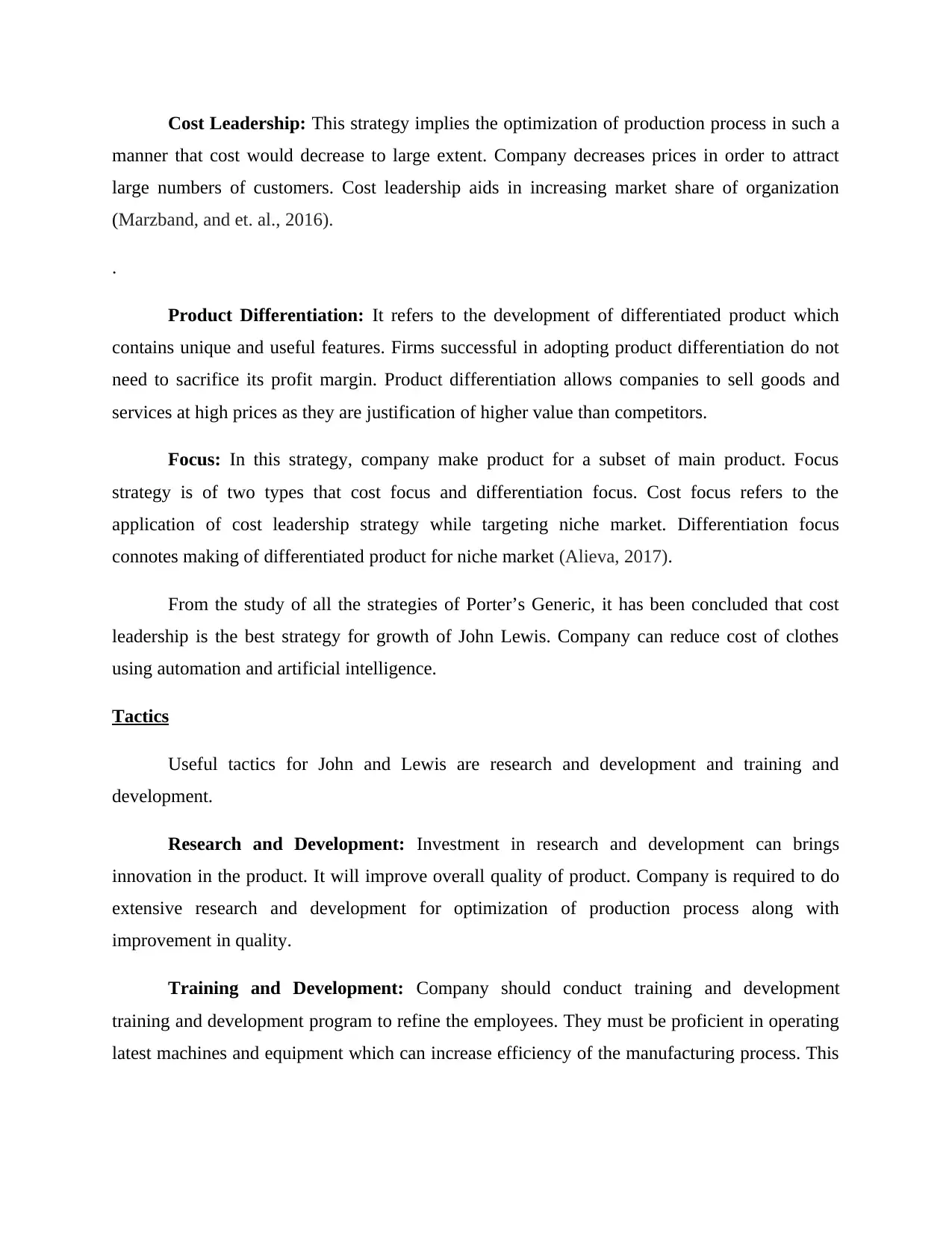
Cost Leadership: This strategy implies the optimization of production process in such a
manner that cost would decrease to large extent. Company decreases prices in order to attract
large numbers of customers. Cost leadership aids in increasing market share of organization
(Marzband, and et. al., 2016).
.
Product Differentiation: It refers to the development of differentiated product which
contains unique and useful features. Firms successful in adopting product differentiation do not
need to sacrifice its profit margin. Product differentiation allows companies to sell goods and
services at high prices as they are justification of higher value than competitors.
Focus: In this strategy, company make product for a subset of main product. Focus
strategy is of two types that cost focus and differentiation focus. Cost focus refers to the
application of cost leadership strategy while targeting niche market. Differentiation focus
connotes making of differentiated product for niche market (Alieva, 2017).
From the study of all the strategies of Porter’s Generic, it has been concluded that cost
leadership is the best strategy for growth of John Lewis. Company can reduce cost of clothes
using automation and artificial intelligence.
Tactics
Useful tactics for John and Lewis are research and development and training and
development.
Research and Development: Investment in research and development can brings
innovation in the product. It will improve overall quality of product. Company is required to do
extensive research and development for optimization of production process along with
improvement in quality.
Training and Development: Company should conduct training and development
training and development program to refine the employees. They must be proficient in operating
latest machines and equipment which can increase efficiency of the manufacturing process. This
manner that cost would decrease to large extent. Company decreases prices in order to attract
large numbers of customers. Cost leadership aids in increasing market share of organization
(Marzband, and et. al., 2016).
.
Product Differentiation: It refers to the development of differentiated product which
contains unique and useful features. Firms successful in adopting product differentiation do not
need to sacrifice its profit margin. Product differentiation allows companies to sell goods and
services at high prices as they are justification of higher value than competitors.
Focus: In this strategy, company make product for a subset of main product. Focus
strategy is of two types that cost focus and differentiation focus. Cost focus refers to the
application of cost leadership strategy while targeting niche market. Differentiation focus
connotes making of differentiated product for niche market (Alieva, 2017).
From the study of all the strategies of Porter’s Generic, it has been concluded that cost
leadership is the best strategy for growth of John Lewis. Company can reduce cost of clothes
using automation and artificial intelligence.
Tactics
Useful tactics for John and Lewis are research and development and training and
development.
Research and Development: Investment in research and development can brings
innovation in the product. It will improve overall quality of product. Company is required to do
extensive research and development for optimization of production process along with
improvement in quality.
Training and Development: Company should conduct training and development
training and development program to refine the employees. They must be proficient in operating
latest machines and equipment which can increase efficiency of the manufacturing process. This
Paraphrase This Document
Need a fresh take? Get an instant paraphrase of this document with our AI Paraphraser
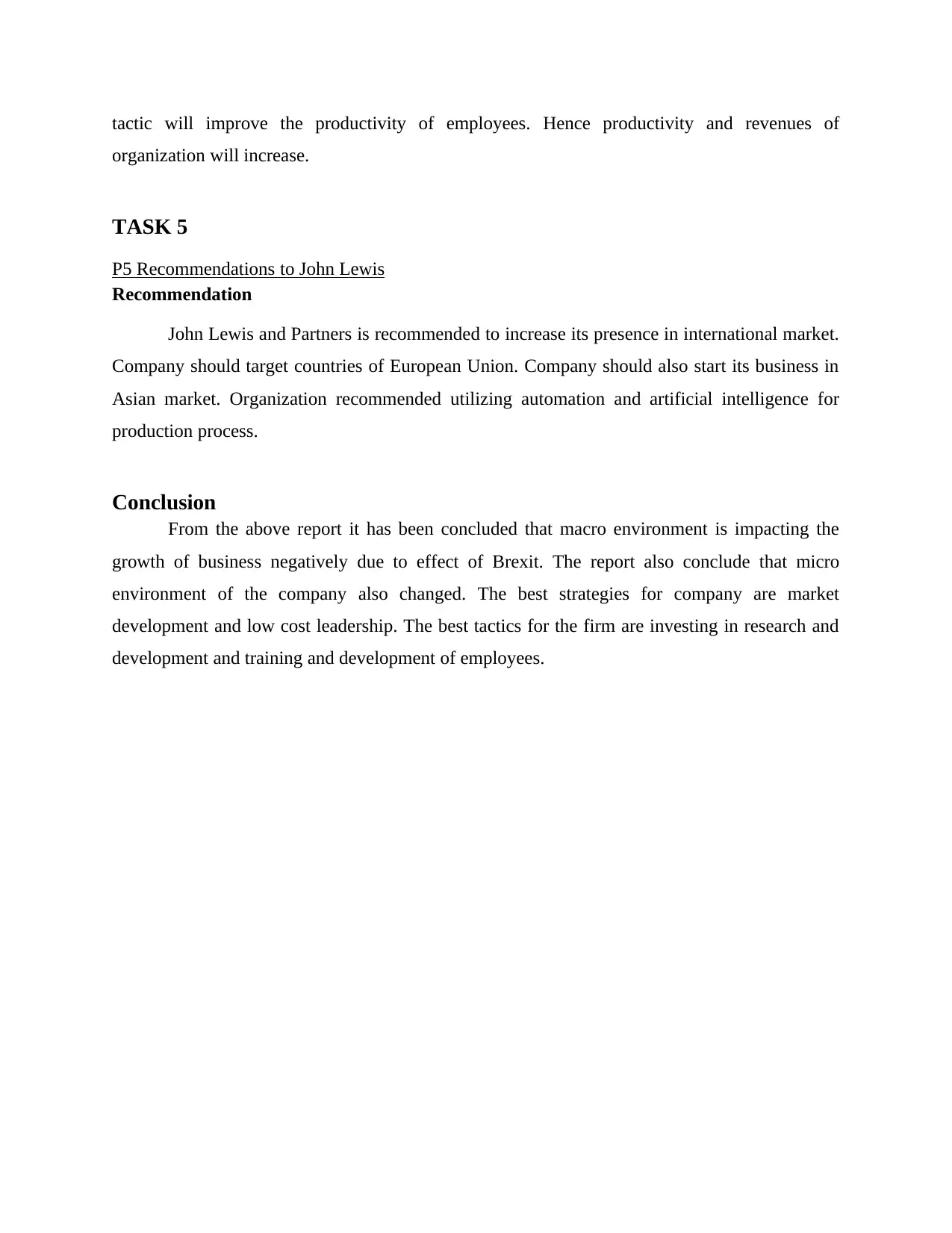
tactic will improve the productivity of employees. Hence productivity and revenues of
organization will increase.
TASK 5
P5 Recommendations to John Lewis
Recommendation
John Lewis and Partners is recommended to increase its presence in international market.
Company should target countries of European Union. Company should also start its business in
Asian market. Organization recommended utilizing automation and artificial intelligence for
production process.
Conclusion
From the above report it has been concluded that macro environment is impacting the
growth of business negatively due to effect of Brexit. The report also conclude that micro
environment of the company also changed. The best strategies for company are market
development and low cost leadership. The best tactics for the firm are investing in research and
development and training and development of employees.
organization will increase.
TASK 5
P5 Recommendations to John Lewis
Recommendation
John Lewis and Partners is recommended to increase its presence in international market.
Company should target countries of European Union. Company should also start its business in
Asian market. Organization recommended utilizing automation and artificial intelligence for
production process.
Conclusion
From the above report it has been concluded that macro environment is impacting the
growth of business negatively due to effect of Brexit. The report also conclude that micro
environment of the company also changed. The best strategies for company are market
development and low cost leadership. The best tactics for the firm are investing in research and
development and training and development of employees.
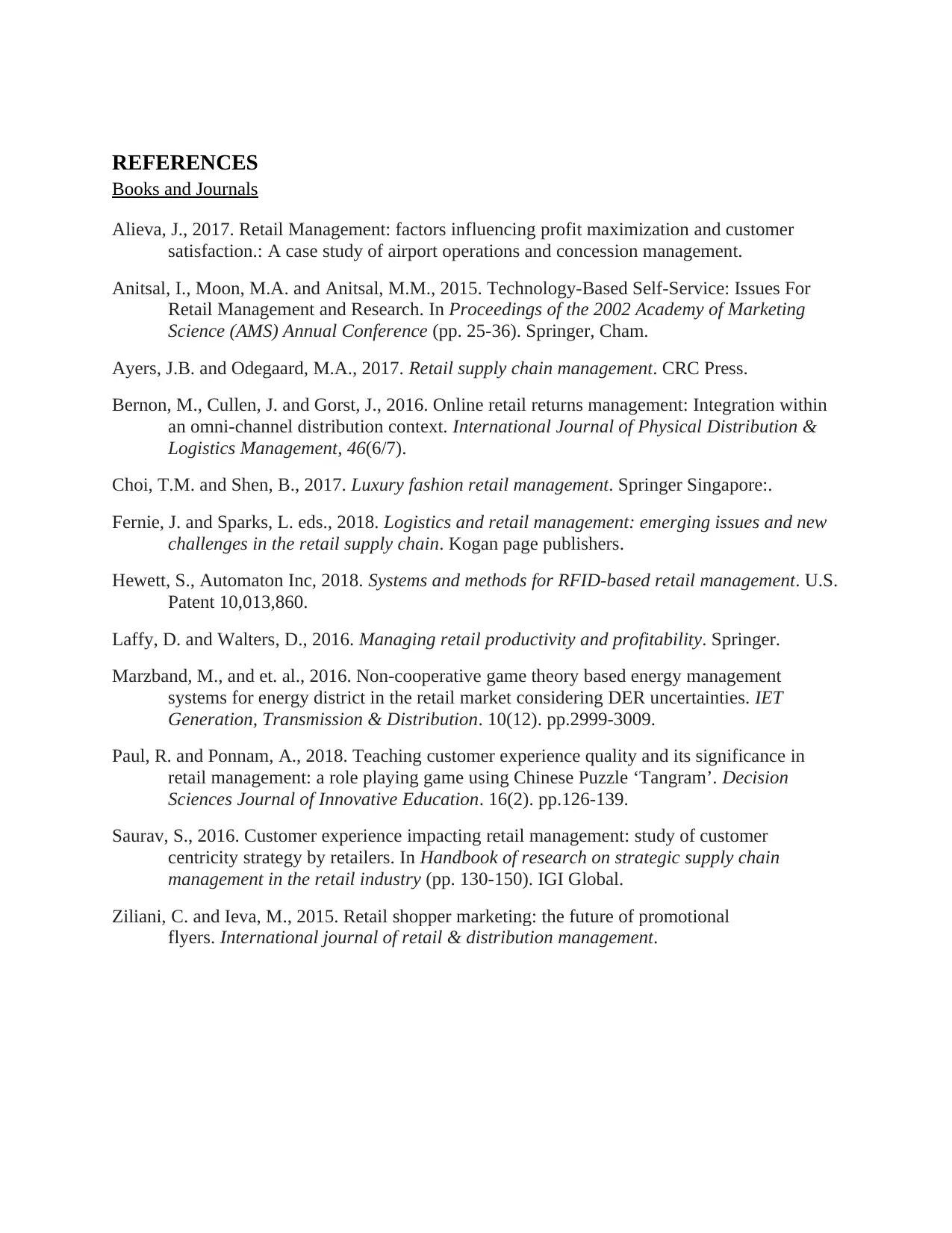
REFERENCES
Books and Journals
Alieva, J., 2017. Retail Management: factors influencing profit maximization and customer
satisfaction.: A case study of airport operations and concession management.
Anitsal, I., Moon, M.A. and Anitsal, M.M., 2015. Technology-Based Self-Service: Issues For
Retail Management and Research. In Proceedings of the 2002 Academy of Marketing
Science (AMS) Annual Conference (pp. 25-36). Springer, Cham.
Ayers, J.B. and Odegaard, M.A., 2017. Retail supply chain management. CRC Press.
Bernon, M., Cullen, J. and Gorst, J., 2016. Online retail returns management: Integration within
an omni-channel distribution context. International Journal of Physical Distribution &
Logistics Management, 46(6/7).
Choi, T.M. and Shen, B., 2017. Luxury fashion retail management. Springer Singapore:.
Fernie, J. and Sparks, L. eds., 2018. Logistics and retail management: emerging issues and new
challenges in the retail supply chain. Kogan page publishers.
Hewett, S., Automaton Inc, 2018. Systems and methods for RFID-based retail management. U.S.
Patent 10,013,860.
Laffy, D. and Walters, D., 2016. Managing retail productivity and profitability. Springer.
Marzband, M., and et. al., 2016. Non-cooperative game theory based energy management
systems for energy district in the retail market considering DER uncertainties. IET
Generation, Transmission & Distribution. 10(12). pp.2999-3009.
Paul, R. and Ponnam, A., 2018. Teaching customer experience quality and its significance in
retail management: a role playing game using Chinese Puzzle ‘Tangram’. Decision
Sciences Journal of Innovative Education. 16(2). pp.126-139.
Saurav, S., 2016. Customer experience impacting retail management: study of customer
centricity strategy by retailers. In Handbook of research on strategic supply chain
management in the retail industry (pp. 130-150). IGI Global.
Ziliani, C. and Ieva, M., 2015. Retail shopper marketing: the future of promotional
flyers. International journal of retail & distribution management.
Books and Journals
Alieva, J., 2017. Retail Management: factors influencing profit maximization and customer
satisfaction.: A case study of airport operations and concession management.
Anitsal, I., Moon, M.A. and Anitsal, M.M., 2015. Technology-Based Self-Service: Issues For
Retail Management and Research. In Proceedings of the 2002 Academy of Marketing
Science (AMS) Annual Conference (pp. 25-36). Springer, Cham.
Ayers, J.B. and Odegaard, M.A., 2017. Retail supply chain management. CRC Press.
Bernon, M., Cullen, J. and Gorst, J., 2016. Online retail returns management: Integration within
an omni-channel distribution context. International Journal of Physical Distribution &
Logistics Management, 46(6/7).
Choi, T.M. and Shen, B., 2017. Luxury fashion retail management. Springer Singapore:.
Fernie, J. and Sparks, L. eds., 2018. Logistics and retail management: emerging issues and new
challenges in the retail supply chain. Kogan page publishers.
Hewett, S., Automaton Inc, 2018. Systems and methods for RFID-based retail management. U.S.
Patent 10,013,860.
Laffy, D. and Walters, D., 2016. Managing retail productivity and profitability. Springer.
Marzband, M., and et. al., 2016. Non-cooperative game theory based energy management
systems for energy district in the retail market considering DER uncertainties. IET
Generation, Transmission & Distribution. 10(12). pp.2999-3009.
Paul, R. and Ponnam, A., 2018. Teaching customer experience quality and its significance in
retail management: a role playing game using Chinese Puzzle ‘Tangram’. Decision
Sciences Journal of Innovative Education. 16(2). pp.126-139.
Saurav, S., 2016. Customer experience impacting retail management: study of customer
centricity strategy by retailers. In Handbook of research on strategic supply chain
management in the retail industry (pp. 130-150). IGI Global.
Ziliani, C. and Ieva, M., 2015. Retail shopper marketing: the future of promotional
flyers. International journal of retail & distribution management.
⊘ This is a preview!⊘
Do you want full access?
Subscribe today to unlock all pages.

Trusted by 1+ million students worldwide
1 out of 12
Related Documents
Your All-in-One AI-Powered Toolkit for Academic Success.
+13062052269
info@desklib.com
Available 24*7 on WhatsApp / Email
![[object Object]](/_next/static/media/star-bottom.7253800d.svg)
Unlock your academic potential
Copyright © 2020–2025 A2Z Services. All Rights Reserved. Developed and managed by ZUCOL.





